15 Types of Butterfly Caterpillars and What They Become (With Pictures)

Caterpillars that turn into butterflies are colorful worm-like crawling insects in all shapes and sizes. Butterfly caterpillars typically have a smooth body, and some exotic-looking caterpillars may have a spiny appearance. In addition, butterfly larvae or caterpillars can be green, brown, black or yellow and have identifiable stripes, patterns, and other recognizable features.
Identifying caterpillars that become butterflies is relatively easy. Species of caterpillar butterflies have specific characteristics allowing you to know the type of butterfly it becomes.
For example, the famous monarch butterfly starts life as a distinctive black, white, and yellow striped caterpillar. However, the zebra longwing butterfly caterpillar is a grayish cylindrical caterpillar covered in black, fleshy spikes. But the dark brown mourning cloak butterfly is a spiky black caterpillar with stinging spines on its body.
This article is a comprehensive guide to identifying types of butterfly caterpillars. Descriptions and pictures of the caterpillars and butterflies will help spot these worm-like insects in a garden landscape, park, or woodland.
Butterfly Caterpillar Identification
Butterfly caterpillars are identified by their size, smooth body, colorful patterns, distinctive markings, and the host plants where they feed. Other features to help identify these caterpillars are the presence of horns, branched spikes, or spines. Additionally, caterpillars that become butterflies have six front legs and several stumpy prolegs.
Another way to identify butterfly caterpillars is by their pupae. When they enter the pupal stage, butterfly caterpillars develop a hard-shelled chrysalis. In addition, unlike some moth caterpillars, caterpillars that become butterflies never pupate in the soil.
Although some caterpillars have fleshy spikes, they typically lack the hairy bodies that characterize many moth caterpillars. Therefore, if you find a smooth-bodied caterpillar without tufts of wispy hairs, the chances are you have found a butterfly caterpillar. However, it’s good to remember that some moth caterpillars also have smooth bodies.
Types of Butterfly Caterpillars (With Pictures) — Identification Guide
Here are some of the most common and spectacular butterfly caterpillars you will likely encounter.
Black Swallowtail Butterfly Caterpillar (Papilio polyxenes)
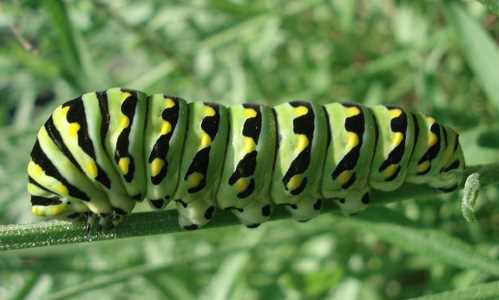
A mature black swallowtail butterfly caterpillar has green body with black stripes and yellow dots
The black swallowtail caterpillar is a large, plump lime-green larva with black and yellow bands traversing its segments. The bright green striped caterpillar also has a characteristic of displaying an orange forked gland and releasing a foul odor when threatened. The large green caterpillar grows 2” (50 mm) long.
In the immature stage, black swallowtail caterpillars are spiky brown caterpillars with a broad white saddle band around their middle.

The black swallowtail is a large beautiful butterfly with black and yellow wings, and red and blue markings
After pupation, the caterpillar turns into the stunning black swallowtail butterfly. This black-winged insect has beautiful yellow, white, and blue markings on its wings. The wings also have two conspicuous red markings near the base. The adult black swallowtails have a wingspan of 2.7” to 3.3” (70 – 84 mm).
- Adult Stage: Black swallowtail butterfly
- Host Plants: Feeds on the leaves of various plants such as milkweed, including members of the carrot family (Apiaceae) such as parsley, dill, fennel, and Queen Anne’s lace
- Habitat and Distribution: Found in diverse habitats, including gardens, fields, meadows, and open areas, throughout North America
- Stinging: The black swallowtail caterpillar does not possess stinging capabilities or cause skin irritation
Eastern Tiger Swallowtail Butterfly Caterpillar (Papilio glaucus)
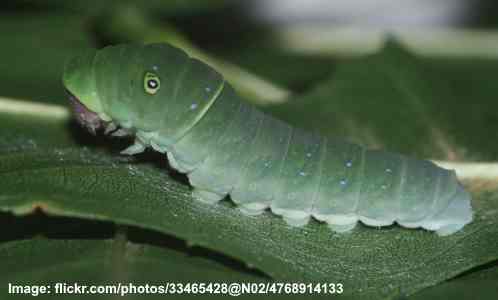
The green tiger swallowtail butterfly caterpillar has eye-like markings on its head
The eastern tiger swallowtail butterfly larva is an unusual caterpillar with a dark green body, faint bands between its segments, and distinctive eyespots on its head. The stumpy green caterpillar has a large head in relation to its body. This strange caterpillar starts life brown and white, before turning green, then brown before pupation.
The eastern tiger swallowtail caterpillar grows up to 2.2” (55 mm) in length.
The eastern tiger swallowtail caterpillar has several defensive habits. For example, the caterpillar looks like bird poop in its first three instars. It also has the characteristic action of Papilio caterpillars of displaying a forked “tongue” and emitting a foul stench to defend itself. It’s a common caterpillar in Texas.
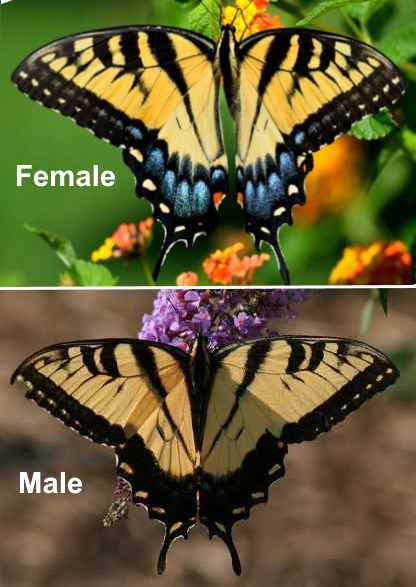
Male tiger swallowtails have black and yellow wings while females also have blue markings on the hind wings
After pupation, the small green caterpillar becomes a spectacular yellow butterfly with black markings around its wings. The large butterfly has a wingspan of 3” to 5.5” (76 to 140 mm).
- Adult Stage: Tiger swallowtail butterfly
- Host Plants: Feeds on various plants including wild cherry, tulip tree, and ash
- Habitat and Distribution: Found in a variety of habitats such as woodlands, parks, and gardens, primarily in North America
- Stinging: The tiger swallowtail caterpillar does not possess stinging capabilities or cause skin irritation
Cabbage White Butterfly Caterpillar (Pieris rapae)
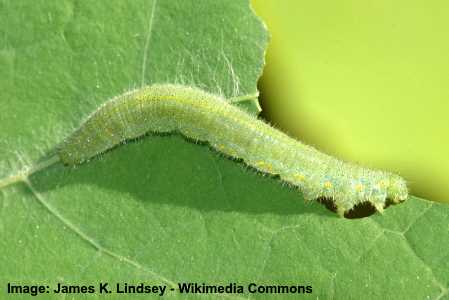
The green cabbage white butterfly caterpillar is commonly found on cruciferous vegetables
The cabbage white butterfly larva is a slender, pale green caterpillar with pale yellowish dots, a yellow longitudinal line, and fine setae (hairs) covering its body that grows 1” (25 mm) long. During some stages, the caterpillar’s head is black. Also called the cabbageworm, the fuzzy green caterpillar is typically found on the underside of cabbage leaves.
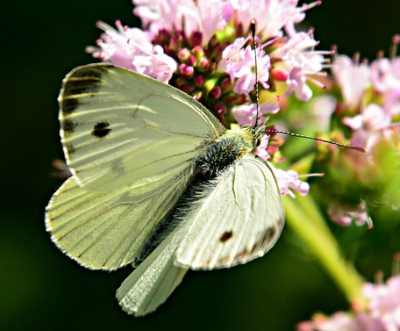
The cabbage white butterfly is very common in many gardens
After pupating, the worm-like caterpillar becomes the cabbage white butterfly. This butterfly is recognized by its creamy-white wings with small black or brown dots on them. The butterfly’s black body is relatively small, and it has two slender clubbed antennae. Its wingspan is 1.3” to 1.9” (32 – 47 mm).
- Adult Stage: Cabbage white butterfly
- Host Plants: Feeds on various plants from the Brassicaceae family, including cabbage, broccoli, and mustard greens
- Habitat and Distribution: Found in diverse habitats such as gardens, agricultural areas, and open spaces, primarily across Europe, Asia, and North America
- Stinging: The cabbage white butterfly caterpillar does not possess stinging capabilities or cause skin irritation
Hackberry Emperor Butterfly Caterpillar (Asterocampa celtis)
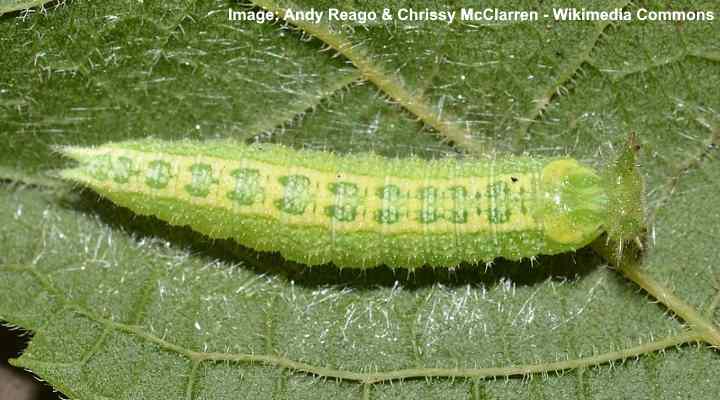
The hackberry emperor butterfly caterpillar is pale green with yellowish stripe along its body and a split tail at its rear
The hackberry emperor butterfly larva is a broad, cylindrical pale green caterpillar with a band of yellow markings along its back that grows 1.4” (35 mm) long. The other identifiable features of this green caterpillar are its unusual spiny horns on its head, split tail end, and tiny pale green spines on its body.
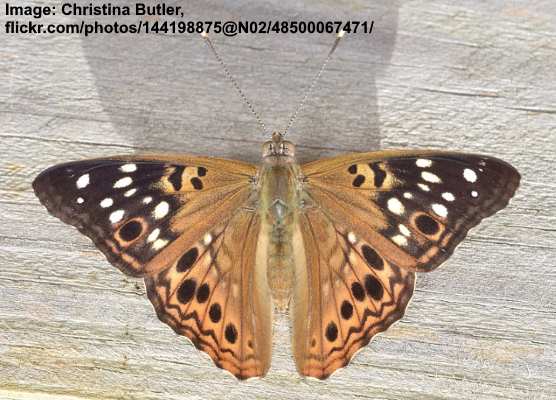
The hackberry emperor is an attractive dark and light brown butterfly with white and black markings
The hackberry emperor butterfly is an eye-catching brown-winged flying insect. The butterfly’s wing coloration is dark brown and light brown with black, yellow, and white spots. The underside of the wings is white and blue with circles of black, blue, and yellow dots. Its wingspan is 2” to 2.6” (50 – 66 mm).
- Adult Stage: Develops into the hackberry emperor butterfly
- Caterpillar Feeds on: Various host plants, including hackberry (Celtis species)
- Habitat: Found in parts of North America in a range of habitats, including woodlands and open areas where hackberry trees grow
- Stinging: Does not sting
Cloudless Sulphur Butterfly Caterpillar (Phoebis sennae)
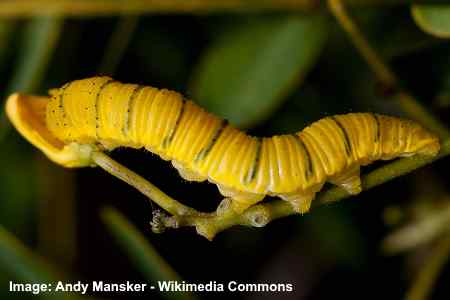
The bright yellow cloudless sulphur butterfly caterpillar has darker bands between its segments
The cloudless sulphur butterfly larva is an eye-catching yellow caterpillar with thin black bands traversing its cylindrical body. The golden yellow caterpillar is a typical butterfly caterpillar with a smooth body and no hairs. Another characteristic of the yellow larva is its indentations that give the appearance of bands.
In some instars (growth stages), the slug-like caterpillar is pale to dark green with a yellow band along its sides and covered in bluish dots.
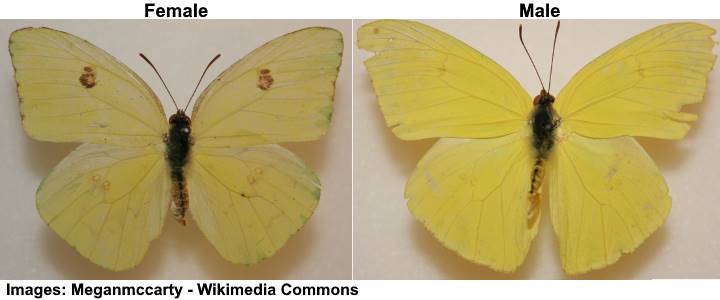
Cloudless Sulphur Butterfly Caterpillar (Phoebis sennae)
The cloudless sulphur butterfly is a pretty yellow insect with pale yellow wings and brown margins. The female butterfly is distinguishable from the male by its brownish marking and black dots on its forewings. The yellow butterfly’s wingspan is 1.9” to 2.6” (48 – 65 mm).
- Adult Stage: Transforms into the cloudless sulphur butterfly
- Caterpillar Feeds on: Various plants, primarily members of the legume family (Fabaceae)
- Habitat: Found in open areas, gardens, and fields. Common and widely distributed in the Americas
- Stinging: Does not sting
Gulf Fritillary / Passion Butterfly Caterpillar (Agraulis vanillae)

The spiky gulf fritillary butterfly caterpillar has orange body with black or gray stripes along its sides
The passion butterfly larva is an eye-catching orange and black caterpillar covered in black branched spines. The dark orange caterpillar grows 0.5” (1.2 cm) long and has a slender, cylindrical body with six black prolegs and six small forelegs. It also has two black curved spiny horns at its head. You will often find the caterpillar in Florida feeding on plants in the Passifloraceae family.
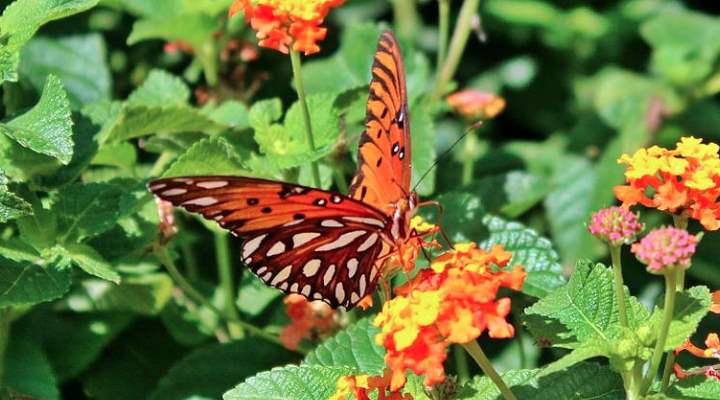
The beautiful Gulf fritillary orange butterfly has brown and white markings on its wings
The Gulf fritillary butterfly is a brightly-colored orange butterfly with brown wing markings and three white dots on its forewings. The orange butterflies have a wing span of 2.5” to 3.7” (65 – 95 mm).
- Adult Stage: Gulf fritillary butterfly
- Host Plants: Passionflowers (Passiflora species) are the primary host plants for this caterpillar
- Habitat and Distribution: Found in the southern United States, Central and South America, and as far south as Argentina
- Stinging: The gulf fritillary caterpillar does not sting
Mourning Cloak Butterfly Caterpillar (Nymphalis antiopa)
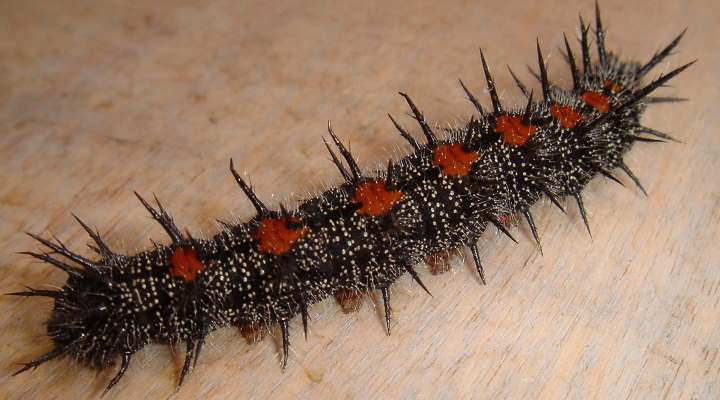
The spiky black mourning cloak butterfly caterpillar has orange-red markings and tiny white dots on its body
The mourning cloak butterfly larva is called the spiny elm caterpillar and measures 2” (50 mm) long. This spiky worm-like creature is a spiny black caterpillar with orangey-red dots along its back. Easy to identify, the spiny elm caterpillar has sharp-looking spikes but it is entirely harmless.

The attractive brown mourning cloak butterfly has wings with yellow margins and blue dots
The mourning cloak butterfly is a dark, chocolatey-brown flying insect with a bright golden yellow margin among its wings. There is also a band of blue dots on its wing margins. The wingspan of the brown and yellow butterfly is 3” (75 mm).
- Adult Stage: Mourning cloak butterfly
- Host Plants: Feeds on a variety of trees including willow, elm, poplar, and hackberry
- Habitat and Distribution: Found in diverse habitats such as woodlands, parks, and gardens, primarily across North America, Europe, and Asia
- Stinging: The mourning cloak caterpillar does not possess stinging capabilities or cause skin irritation
Monarch Butterfly Caterpillar (Danaus plexippus)

The monarch butterfly caterpillar is yellow, white, and black striped caterpillar
The monarch butterfly in its larval stage is an easy-to-recognize striped caterpillar. Each of the caterpillar’s segments has a black, white, and yellow bands. Other characteristic features of the stripy creature are its long black fleshy horns and two stumpy tail appendages.
The striped monarch butterfly caterpillar is poisonous to birds and predators. This is because the larva feeds on milkweed that creates toxins in its body, making it unappetizing to other animals.

The monarch butterfly is very popular with black and orange wings and white spots
After pupating, the black and yellow caterpillar becomes the spectacular monarch butterfly. This iconic butterfly has bright orange wings with black vein-like patterns, giving it a stained-glass window appearance. The black and orange butterfly has a 3.5” to 4” (90 – 102 mm) wingspan.
- Adult Stage: Monarch butterfly
- Host Plants: Mainly feeds on milkweed plants, including common milkweed, swamp milkweed, and others in the Asclepias genus
- Habitat and Distribution: Found in various habitats including fields, meadows, and gardens, primarily across North America, but also found in some parts of South America, Western Europe, and Australia
- Stinging: Monarch caterpillars do not sting or cause skin irritation
Queen Butterfly Caterpillar (Danaus gilippus)

The queen butterfly caterpillar has black and white stripes with yellow markings
The queen butterfly larva is a black and white striped caterpillar with yellow dots on black bands that measures around 3” (75 mm) long. The plump stripy caterpillar has six fleshy tentacles—two at the front, two near the head, and two at its tail end. Variations in its color patterns include yellow, green, blue, blackish brown, and white.
Like the monarch caterpillar, this species also feeds on milkweed.
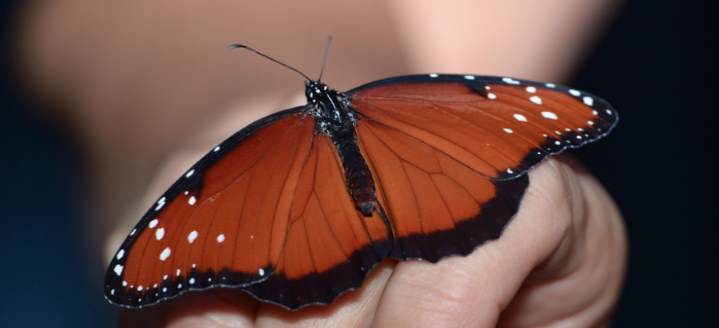
The brown-orange queen butterfly has black margins and white dots on its wings
The queen butterfly is an attractive rusty-brown or orange butterfly with several white dots on its wings. There is also a black band around its wings’ margins. The difference between the queen and monarch butterfly is that it doesn’t have the black veins characteristic of the monarch.
- Adult Stage: Queen butterfly
- Host Plants: Feeds on various species of milkweed, including Asclepias curassavica and other related plants
- Habitat and Distribution: Found in diverse habitats such as open areas, meadows, and gardens, primarily in North and South America
- Stinging: The queen butterfly caterpillar does not possess stinging capabilities or cause skin irritation
Zebra Longwing Butterfly Caterpillar (Heliconius charithonia)
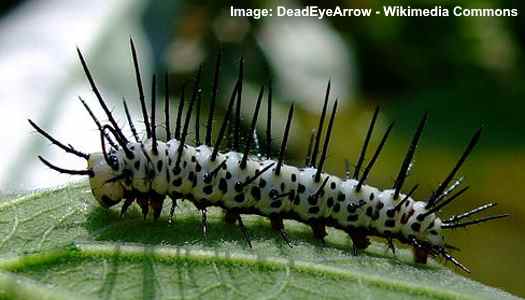
The zebra longwing butterfly caterpillar has gray body, black dots and many spikes
In its larval stage, the zebra longwing butterfly is a grayish-green caterpillar covered in long, branched black spines. The gray and black cylindrical caterpillar is also covered in black dots. The creature moves around on spiny black legs. You’ll often find this gray caterpillar feeding on passionflower plants.
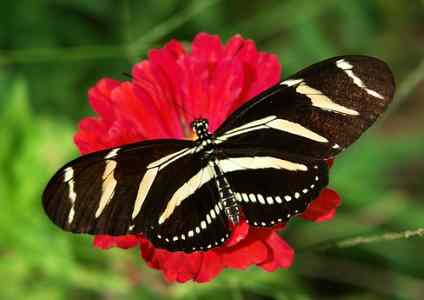
The zebra longwing butterfly has black and white striped wings with white dots
Looking at the zebra longwing butterfly pictures, it’s easy to see where it gets its name. The dark brown to black butterfly has white stripes giving a zebra-like appearance. These large black and white butterflies have a wingspan of 2.8” to 3.9” (72 to 100 mm).
- Adult Stage: Zebra longwing butterfly
- Host Plants: Feeds on various passionflower vine species, including Passiflora suberosa and Passiflora incarnata
- Habitat and Distribution: Found in a variety of habitats such as tropical forests, gardens, and coastal areas, primarily in the southern United States, Mexico, Central America, and South America
- Stinging: The zebra longwing butterfly caterpillar does not possess stinging capabilities or cause skin irritation
White Admiral Butterfly Caterpillar (Limenitis arthemis)
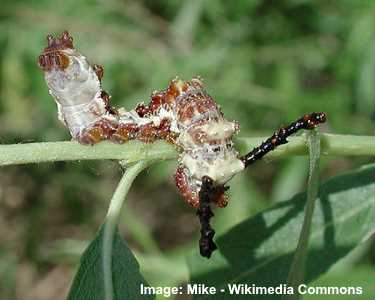
The white admiral butterfly caterpillar is a horned caterpillar that looks like bird droppings
The white admiral butterfly in its caterpillar stage looks like bird droppings. The strange-looking olive-green or brown and white caterpillar has a jagged appearance. The white blotches and its uneven shape make it easy to camouflage itself on branches. The caterpillar has two large, spiked horns at its head.
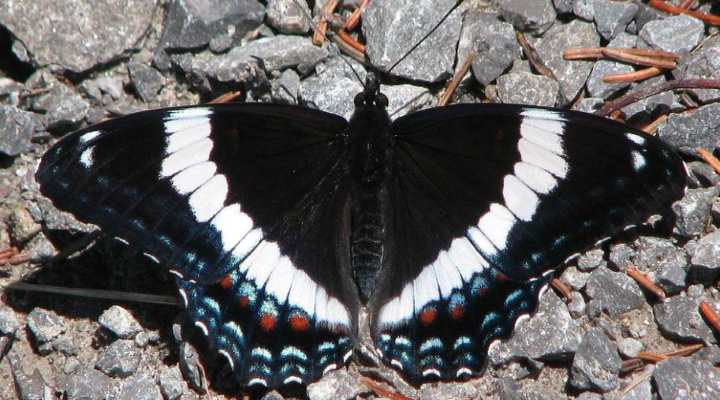
The white admiral butterfly has black wings with white band and red and blue dots
The white admiral butterfly looks nothing like the disgusting-looking caterpillar before pupating. The butterfly has jet-black wings with a conspicuous white band running from top to bottom. In addition, the underside of the large wings is decorated with orangey-red dots.
Some species have iridescent blue wings with shades of pale orange. Its wingspan is 1.85” to 3.07” (47 – 78 mm).
- Adult Stage: White admiral butterfly
- Host Plants: Feeds on various species of plants, including birch, cherry, poplar, and willow
- Habitat and Distribution: Found in diverse habitats such as forests, woodlands, and along streams, primarily across North America and some parts of Canada
- Stinging: The white admiral caterpillar does not possess stinging capabilities or cause skin irritation
Peacock Butterfly Caterpillar (Aglais io)
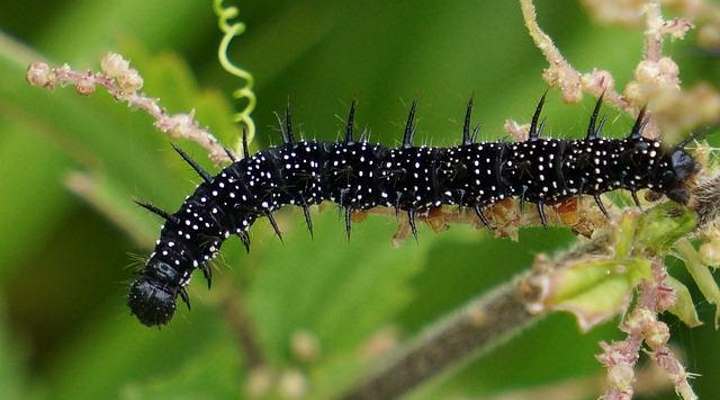
The peacock butterfly caterpillar can be identified by its black bristles and tiny white dots on its body
The larva stage of the peacock butterfly looks like a long, slender black caterpillar covered in white dots and black spikes. This spiky black caterpillar looks threatening. However, its fleshy spines are harmless, and the caterpillar doesn’t sting. The shiny black larva’s body is easy to spot, standing out against green foliage.
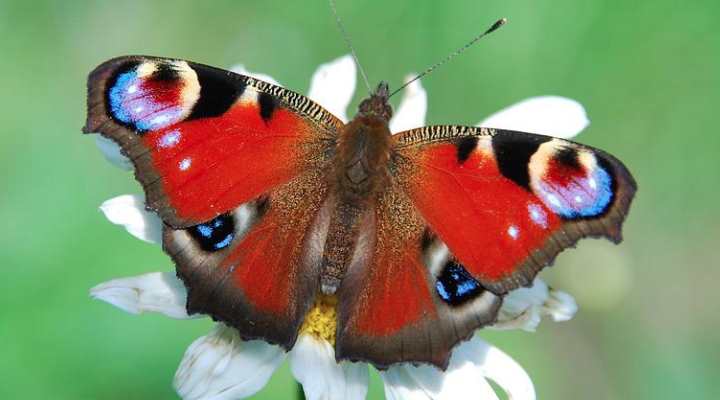
The spectacular peacock butterfly has reddish wings with colorful eye markings
The peacock butterfly caterpillar turns into a stunning butterfly with rusty red wings. Each wing has an impressive blue and red eyespot in the top corner to frighten predators. The underside of the butterfly’s wings is a mottled black and dark brown pattern. It has a wingspan of 2” to 2.1” (50 – 55 mm).
- Adult Stage: The peacock caterpillar matures into a beautiful butterfly known as the European peacock butterfly
- Host Plants: The caterpillar primarily feeds on nettles, making them a common sight in areas where nettles grow
- Habitat and Distribution: Peacock caterpillars are widespread throughout Europe and parts of Asia, typically found in gardens, meadows, and wooded areas
- Stinging: Peacock caterpillars are harmless and do not possess stinging capabilities
Pearl Crescent Butterfly Caterpillar (Phyciodes tharos)
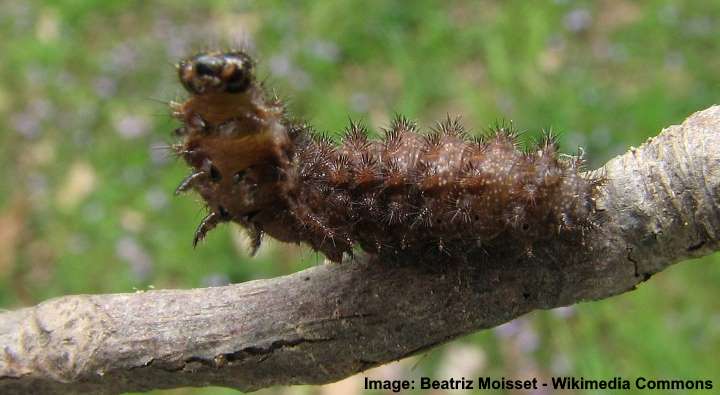
The pearl crescent butterfly caterpillar is identified by its dark brown body, tiny white dots and small spiky hairs
The pearl crescent butterfly, in its larval stage, is a spiky brown ugly caterpillar. The fat, spiny milky coffee-colored caterpillar is covered in white dots and tufts of short spines. A characteristic habit of this brown caterpillar is how it raises its front section in a defensive position when threatened.

The pearl crescent butterfly has orange wings with dark brown or blackish patterns
The dark brown caterpillar turns into the attractive orange and brown pearl crescent butterfly. The butterfly has rusty orange wings with prominent black markings creating an intricate pattern. The butterfly has a 0.82” to 1.33” (21 – 34 mm) wingspan.
- Adult Stage: Pearl crescent butterfly
- Caterpillar Feeds on: Feeds on aster leaves
- Habitat: Often found feeding on aster leaves; primarily found in North America
- Stinging: No, they do not have stinging hairs
American Painted Lady Butterfly Caterpillar (Vanessa virginiensis)
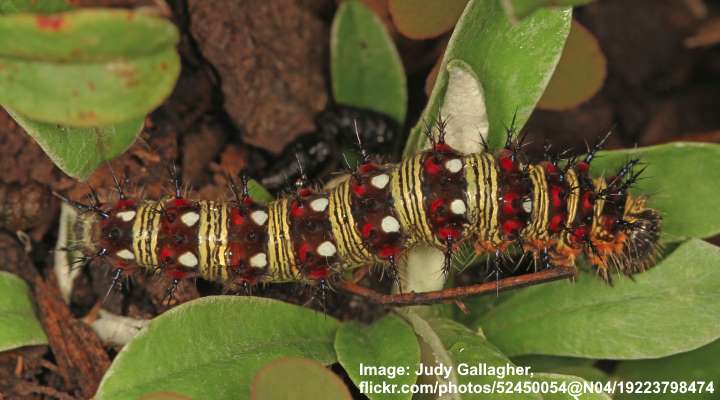
The American painted lady butterfly caterpillar has pale yellow stripes on its brown body with red and white dots
The American painted lady butterfly larva is described as a spiny colorful brown caterpillar with yellow traversing bands and red and creamy-yellow spots on its abdomen. The spotted brown and yellow caterpillar is highly unusual due to its patterning. The yellow bands around its brown body have thin black lines.

American painted lady butterfly has interesting patterns on both upper and undersides
Also called the American lady, the spiky caterpillar turns into an attractive orange and brown butterfly, identified by its four conspicuous eyespots on the wings’ ventral sides (undersides). The wings’ upper side (dorsal) is primarily orange with brown tips, white spots, and dark brown to black markings.
- Adult Stage: American painted lady butterfly
- Caterpillar Feeds on: Ironweed, asters, pussytoes, and other plants
- Habitat: Feeds on host plants in various habitats, including open areas and gardens; primarily found in North America
- Stinging: No, they do not have stinging hairs
Common Buckeye Butterfly Caterpillar (Junonia coenia)
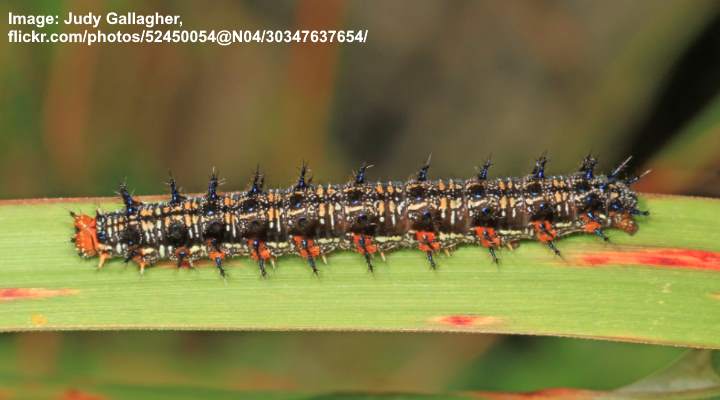
The common buckeye butterfly caterpillar is dark brown with pale markings and orange dots
The common buckeye butterfly larva is a dark-colored black or brown caterpillar with two distinctive stripes along its back and tufts of short, black spines. The spiked caterpillars also have reddish-orange and white spots and grows up to 1.57” (40 mm) long. And an identifying feature of the black caterpillar is its bulbous orange head.
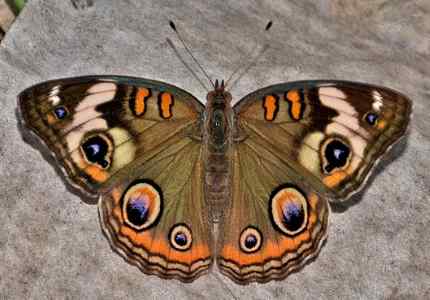
One of the most beautiful butterflies is the buckeye butterfly with its colorful eye-like markings
After pupation, the black spiky larva emerges as a stunning brown buckeye butterfly. The butterfly is identified by its six conspicuous eye spots on its brown wings. In addition, orange markings add to the beauty of this attractive butterfly. Its wingspan is 2” to 2.5” (50 – 65 mm).
- Adult Stage: The adult stage is commonly known as the buckeye butterfly
- Host Plants: Its caterpillars feed on various plants, including those from the snapdragon family (Scrophulariaceae) and plants from the Acanthaceae family
- Habitat and Distribution: The Junonia coenia caterpillar can be found in open areas, gardens, roadsides, and meadows throughout North and South America
- Stinging: There are no reported instances of the Junonia coenia caterpillar causing skin irritation or stinging
Related articles:
